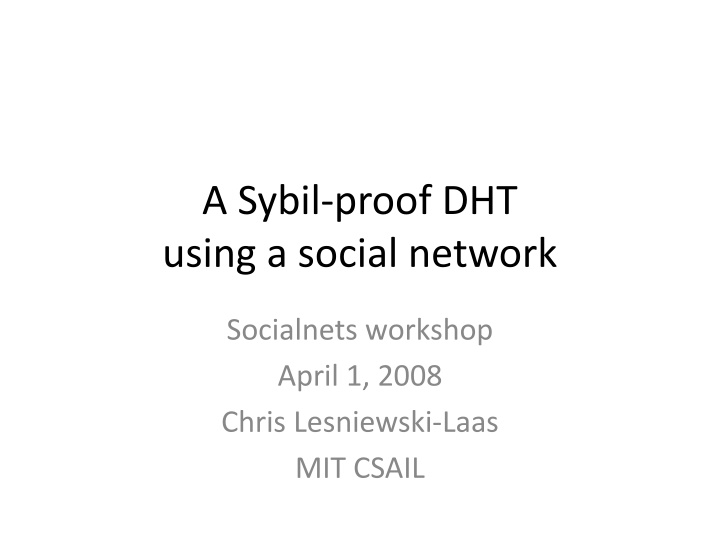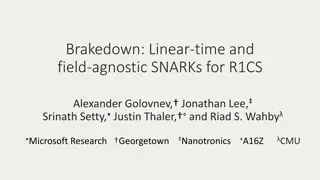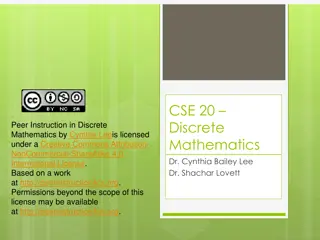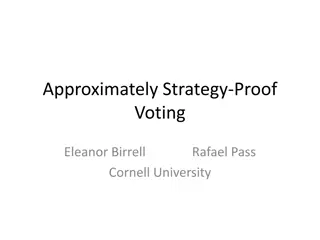Sybil-Proof DHT Using a Social Network
In this presentation, a distributed hash table (DHT) system resistant to Sybil attacks utilizing social network structures is discussed. The use of social links enhances security and scalability, offering insights into countering Sybil attacks in peer-to-peer systems. Various methods, including limiting IDs per IP address, strong PKI, and social network integration, are explored to mitigate such attacks. Practical strategies and implications for secure DHT routing are highlighted.
Download Presentation

Please find below an Image/Link to download the presentation.
The content on the website is provided AS IS for your information and personal use only. It may not be sold, licensed, or shared on other websites without obtaining consent from the author.If you encounter any issues during the download, it is possible that the publisher has removed the file from their server.
You are allowed to download the files provided on this website for personal or commercial use, subject to the condition that they are used lawfully. All files are the property of their respective owners.
The content on the website is provided AS IS for your information and personal use only. It may not be sold, licensed, or shared on other websites without obtaining consent from the author.
E N D
Presentation Transcript
A Sybil-proof DHT using a social network Socialnets workshop April 1, 2008 Chris Lesniewski-Laas MIT CSAIL
Overview Distributed Hash Tables The Sybil attack Model (network, adversary) Tool: random sampling from a social network Sybil-proof DHT protocols
DHT routing in three slides 2160 0 Structured DHT: a layer in many P2P systems Used by requesting node to find another node by ID IDs typically hash of public key: self-certifying DHT maps ID to IP address ID = SHA-1(public key)
DHT routing in three slides Sub-linear table size Nodes need not keep track of all other nodes Reduces bandwidth usage Enables scaling
DHT routing in three slides Routing via intermediate hops Result is authenticated Trade off table size versus routing hops s t {IP addr}PKt {IDt} {IDt} {IDt}
The Sybil Attack One can have, some claim, as many electronic personas as one has time and energy to create. Judith S. Donath
DHTs are subject to the Sybil attack Attacker creates many pseudonyms Disrupts routing or stabilization Douceur, 2002: without a logically centralized authority, Sybil attacks are always possible s t {IDt}
Methods to limit the Sybil attack Limit IDs per IP address Central CA issues IDs Strong PKI CAPTCHA Cryptographic puzzles All methods have drawbacks cost, compatibility, barriers to entry Adversary may have more resources
Social network can help Nodes have social links to other nodes social links established outside of the DHT provides additional information usable by DHT Chris Frans Bryan Andy Robert Sean Jacob Paul Larry
Social network model n = number of honest nodes for this talk only, all nodes have ~same degree g = number of attack edges g = o(n/log n) tolerable by protocol Correctness is independent of number of Sybil nodes! Honest region Sybil region Attack edges
Mixing time Random walk: choose each hop randomly Mixing time: #hops until uniform probability Fast mixing network: mixing time = O(log n)
Sampling by random walks A random walk has o(1) chance of escaping* True when g bounded by o(n/log n) Of r walks, (1-o(1))r = (r) end nodes are good! Can t distinguish good from bad nodes in set Honest region Sybil region escaping paths non-escaping path
Basic one-hop DHT design Construct finger table by r random walks Route to t by asking all fingers about t If r = ( n log n), some finger knows t WHP Adversary cannot interfere with routing s {t s IP address} {know t?} {know t?} {t?} {t?} {t?} {t?} {t?} r {forwarded message from s} t r
Properties of this solution Finger table size: r = O( ) Bandwidth to construct: O(r log n) bits Bandwidth to query: O(r) messages Probability of failure: 1/poly(n) nlog n
Preliminary results Input graph: Orkut scrape 7335 nodes 56211 edges walk length 10 table size r = 1000 g ~ m n/log n 750 2.64% 2.47%
Properties of this solution Finger table size: r = O( ) Bandwidth to construct: O(r log n) bits Bandwidth to query: O(r) messages Probability of failure: 1/poly(n) nlog n
Structured one-hop DHT 2160 0 Goal: reduce bandwidth used by routing lookup Method: add Chord-like structure to DHT Assign hash IDs on ring ID=SHA1(PK)
Structured one-hop DHT Goal: reduce bandwidth used by routing lookup Method: add Chord-like structure to DHT Assign hash IDs on ring Already have finger tables Need successor tables
Constructing successor tables Construct finger tables Sort finger table by ID Tell each finger about its successors in your finger table costs extra messages send O(log n) successors Each node learns its r successors WHP
Using successor tables To route, query closest finger to target finger s successor table should contain target If failed, finger may be evil or simply unlucky Try next closest finger Expect O(1) tries s t
Hard to extend to O(log n) hops Would like to have smaller routing tables this requires more hops per lookup First finger table (from random walks) has o(1) fraction of bad fingers Successive refinements (closer successors in ID space) using Chord stabilization: fraction of bad nodes grows at each step Tricky? Yes. Impossible? Unclear.
Summary DHTs are subject to the Sybil attack Social networks provide useful information Created a Sybil-resistant one-hop DHT Resistant to g = o(n/log n) attack edges Table sizes and routing BW O( n log n) Uses O(1) messages to route This is important: enables fully decentralized and secure peer-to-peer systems
The Tom attack Tom has 230357403 friends.
The Tom attack From: Flickr Mail <mail@flickr.com> Subject: [Flickr] You are aameesh's newest contact! Date: 29 Mar 2008 08:00:19 +0000 To: ctl-flickr@mit.edu Hi Chris Lesniewski, You are aameesh's newest contact! If you don't know aameesh, aameesh is probably a fan of your photos or wants a bookmark so they can find you again. There is no obligation for you to reciprocate, unless you want to. :)
The Tom attack From: Flickr Mail <mail@flickr.com> Subject: [Flickr] You are aameesh's newest contact! Date: 29 Mar 2008 08:00:19 +0000 To: ctl-flickr@mit.edu Hi Chris Lesniewski, You are aameesh's newest contact! If you don't know aameesh, aameesh is probably a fan of your photos or wants a bookmark so they can find you again. There is no obligation for you to reciprocate, unless you want to. :)























